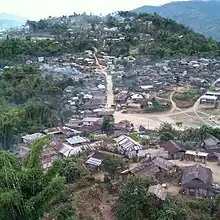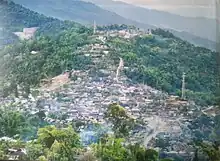Patsho
Patsho is a village in Noklak District, located in the eastern part of Nagaland,[1] and one of the biggest villages in Noklak District.[2] It is situated at an altitude of 1415m above sea level. The village is 37km away from Noklak and 72km from Tuensang, Nagaland.[3] The neighbouring villages are Kingnyu to the east, Tsüvau and Lingnyu to the north east, Yokau and Iekhau to the north, Patsho Nokking and Patsho Town to the south, Kingphu and New Sanglau to the south west, Yakor to the north west and Shamator to the west.[4]


People
The people of Patsho, a Kalyu-kengnyu village were once considered the most formidable in war where opponent from other villagers hesitate to attack and raid the village. They were the master of poisoned arrows being shot at the opponent and strategy of attacking a group of enemies by single man or two, fiercely outperforms them in war. [5] Unlike those days, people now have become humble and kind towards each other, compassionately sharing of food and reaching out hand for the weak. All these is affected by the inception of christianity and introduction of modern education drastically overshadowed the vernacular education. Societal transformation is at its peak feulled by globalization and knowledge transmission through cultural exchanges.
Politics
Patsho forms part of Thonoknyu Assembly constituency #57 in the Nagaland Legislative Assembly.[6]
Economy
Farming and rearing of domestic animals is the mainstay of the village economy but cotton production is still popular, thus enhancing annual household income.[7] It is considered as one of the biggest economy in Noklak district.
Culture
Patsho village can be considered as the cultural centre of folklore and folktale, arts, significant heritage, fashion or modernistic ideas lingers in and around. Thus, may be called cultural hub of the Khiamniungans.[8]

Climate
Patsho village undergoes a sub-tropical climate with four distinct seasons: spring (Miuleih), summer (Asheu), autumn (Ochamju) and winter (A-uh).[9]
Agricultural practice
The people predominantly follow Jhum cultivation and the major crops are maize, rice, yam, millet, Job's tears (adlay millet), Beans, Sweet potatoes, pulses and spices.[10]
Religion
Christianity is the only religion followed by the people and the church has celebrated its 50th anniversary (Golden Jubilee) in 2015.[4]
Demography
As per 2011 Indian Census, the total population of the village is 2117, out of which 1060 are male and 1057 female.[2]
Literacy rate
According to the 2011 Indian census, the literacy rate of this village is 54.87%.[2]
References
- ICAR-National Research Centre on Mithun: "Animal Health Camp and TSP inputs materials distribution programme at Patsho and Yokao village of Noklak district Nagaland"
- Download DH_2011_1307_PART_B_DCHB_TUENSANG.pdf : Census of India 2011 Nagaland, Series-14, Part XII-B: District Census Handbook Tuensang, pp. 88-89
- "INDIAN VILLAGE DIRECTORY". villageinfo.in. villageinfo.
- Students' Community.(1978-2020). Patsho Students' Union 50th anniversary : Souvenir, Theme: Embracing Excellence. publisher artworks.
- : J.H. Hutton, Diaries of Two Tours in the Unadministered Area East of the Naga Hills', 1926
- GENERAL ELECTION TO THE 13th NAGALAND LEGISLATIVE ASSEMBLY, 2018: ANNEXURE - 45 (Chapter XV, Para 15.27.9), FORM 20 (Final Result Sheet)
- "Patsho village, where people still finds weaver and wearer"
- : Patsho village in Noklak district breaks glass ceiling
- "The Frontier District, Noklak"
- : Oral History |SPONSORED UNDER TRIDEPARTMENT OF ART AND CULTUREGOVERNMENT OF NAGALAND